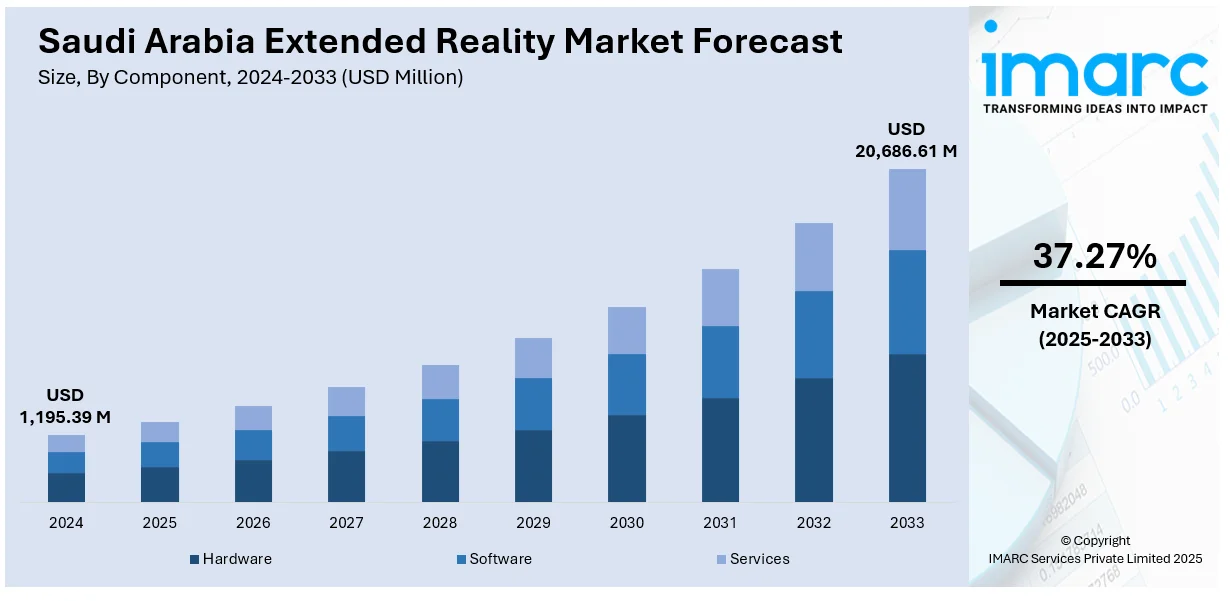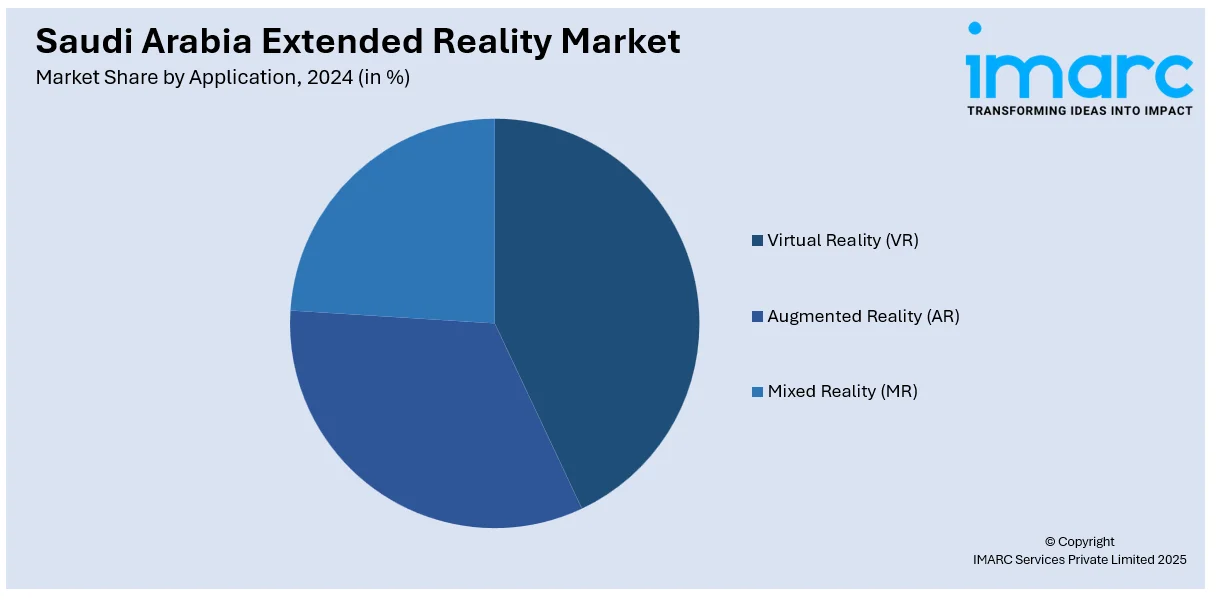
Saudi Arabia Extended Reality Market Size, Share, Trends and Forecast by Component, Type, Organization Size, Application, End User Industry, and Region, 2025-2033
Saudi Arabia Extended Reality Market Overview:
The Saudi Arabia extended reality market size reached USD 1,195.39 Million in 2024. Looking forward, IMARC Group expects the market to reach USD 20,686.61 Million by 2033, exhibiting a growth rate (CAGR) of 37.27% during 2025-2033. The market is advancing rapidly, driven by rising adoption across education, healthcare, mobility, and infrastructure sectors. Strategic partnerships, sector-specific innovations, and national projects like NEOM are boosting demand for immersive solutions, supporting the Kingdom’s broader digital transformation goals, and strengthening Saudi Arabia's extended reality market share.
|
Report Attribute
|
Key Statistics
|
|---|---|
|
Base Year
|
2024 |
|
Forecast Years
|
2025-2033
|
|
Historical Years
|
2019-2024
|
| Market Size in 2024 | USD 1,195.39 Million |
| Market Forecast in 2033 | USD 20,686.61 Million |
| Market Growth Rate 2025-2033 | 37.27% |
Saudi Arabia Extended Reality Market Trends:
Expansion of Industry-Specific Immersive Solutions
Saudi Arabia’s extended reality market is growing steadily as different sectors increasingly adopt immersive technologies to enhance user engagement, operational efficiency, and digital transformation. One of the key drivers behind this trend is the push to create customized XR applications that address the specific needs of industries like education, healthcare, and cultural preservation. In July 2024, 5dVR expanded its operations to Saudi Arabia through a strategic partnership with AstroLabs, introducing immersive AR and VR solutions tailored to these sectors. The Cairo-based company’s entry into the Kingdom allowed educational institutions, healthcare providers, and cultural organizations to access a wider range of interactive and localized digital experiences. This development strengthened the momentum toward sector-driven XR adoption, helping move the market beyond general entertainment-based applications. As businesses across Saudi Arabia continue to look for specialized XR offerings that align with their goals, the demand for content creation, system integration, and workforce training using XR tools is expected to increase. The government’s broader vision of digital innovation and localization further supports this movement, encouraging firms to invest in sector-specific XR technologies. With education, healthcare, and culture showing early success stories, the Saudi XR market is likely to see deeper sectoral penetration and broader ecosystem development in the coming years.

Integration of XR with Smart Mobility and Infrastructure
XR technologies are being deployed to support real-time monitoring, operational planning, and immersive training, which are critical to the success of advanced infrastructure projects, further propelling the Saudi Arabia extended reality market growth. In August 2024, Guident partnered with XRF to integrate XR capabilities with Guident’s Remote Monitor and Control Center (RMCC) platform. This partnership, connected to Saudi Arabia’s NEOM project, introduced virtual command centers that used 3D digital twins and immersive interfaces to monitor autonomous vehicle fleets. Through this collaboration, fleet operators gained new tools for real-time decision-making, emergency response simulation, and efficient operations management. The integration of XR with mobility systems highlighted its practical value in enhancing infrastructure reliability and safety. This trend reflects a broader movement where Saudi Arabia is embedding XR into smart city initiatives, transport systems, and large-scale urban developments. As futuristic projects like NEOM continue to evolve, demand for XR-based remote operations, virtual testing, and immersive maintenance solutions are expected to rise. The focus on combining XR with smart infrastructure positions the technology as a critical enabler of sustainable urban growth, helping Saudi Arabia meet its Vision 2030 innovation goals.
Saudi Arabia Extended Reality Market Segmentation:
IMARC Group provides an analysis of the key trends in each segment of the market, along with forecasts at the country and regional level for 2025-2033. Our report has categorized the market based on component, type, organization size, application, and end user industry.
Component Insights:
- Hardware
- Software
- Services
The report has provided a detailed breakup and analysis of the market based on the component. This includes hardware, software, and services.
Type Insights:
- Consumer Engagement
- Business Engagement
A detailed breakup and analysis of the market based on the type have also been provided in the report. This includes consumer engagement and business engagement.
Organization Size Insights:
- Small and Medium-sized Enterprise
- Large Enterprises
A detailed breakup and analysis of the market based on the organization size have also been provided in the report. This includes small and medium-sized enterprise and large enterprises.
Application Insights:

- Virtual Reality (VR)
- Augmented Reality (AR)
- Mixed Reality (MR)
A detailed breakup and analysis of the market based on the application have also been provided in the report. This includes virtual reality (VR), augmented reality (AR), and mixed reality (MR).
End User Industry Insights:
- Education
- Retail
- Industrial and Manufacturing
- Healthcare
- Media and Entertainment
- Others
A detailed breakup and analysis of the market based on the end user industry have also been provided in the report. This includes education, retail, industrial and manufacturing, healthcare, media and entertainment, and others.
Regional Insights:
- Northern and Central Region
- Western Region
- Eastern Region
- Southern Region
The report has also provided a comprehensive analysis of all the major regional markets, which include Northern and Central region, Western region, Eastern region, and Southern region.
Competitive Landscape:
The market research report has also provided a comprehensive analysis of the competitive landscape. Competitive analysis such as market structure, key player positioning, top winning strategies, competitive dashboard, and company evaluation quadrant has been covered in the report. Also, detailed profiles of all major companies have been provided.
Saudi Arabia Extended Reality Market News:
- March 2025: Diriyah Company launched the Media and Innovation District at MIPIM in Cannes, aiming to advance Saudi Arabia’s technology, media, and communications sectors. By fostering content creation, digital transformation, and technological innovation, the project strengthened the country’s extended reality (XR) ecosystem and attracted global industry leaders.
- August 2024: Guident partnered with XRF to integrate extended reality (XR) solutions into autonomous vehicle monitoring. XRF’s technology, linked to Saudi Arabia’s NEOM project, advanced immersive command centers and simulation training, strengthening the Kingdom’s XR market by enhancing real-time fleet management and operational efficiency.
Saudi Arabia Extended Reality Market Report Coverage:
| Report Features | Details |
|---|---|
| Base Year of the Analysis | 2024 |
| Historical Period | 2019-2024 |
| Forecast Period | 2025-2033 |
| Units | Million USD |
| Scope of the Report | Exploration of Historical Trends and Market Outlook, Industry Catalysts and Challenges, Segment-Wise Historical and Future Market Assessment:
|
| Components Covered | Hardware, Software, Services |
| Types Covered | Consumer Engagement, Business Engagement |
| Organization Sizes Covered | Small and Medium-sized Enterprise, Large Enterprises |
| Applications Covered | Virtual Reality (VR), Augmented Reality (AR), Mixed Reality (MR) |
| End User Industries Covered | Education, Retail, Industrial and Manufacturing, Healthcare, Media and Entertainment, Others |
| Regions Covered | Northern and Central Region, Western Region, Eastern Region, Southern Region |
| Customization Scope | 10% Free Customization |
| Post-Sale Analyst Support | 10-12 Weeks |
| Delivery Format | PDF and Excel through Email (We can also provide the editable version of the report in PPT/Word format on special request) |
Key Questions Answered in This Report:
- How has the Saudi Arabia extended reality market performed so far and how will it perform in the coming years?
- What is the breakup of the Saudi Arabia extended reality market on the basis of the component?
- What is the breakup of the Saudi Arabia extended reality market on the basis of the type?
- What is the breakup of the Saudi Arabia extended reality market on the basis of organization size?
- What is the breakup of the Saudi Arabia extended reality market on the basis of application?
- What is the breakup of the Saudi Arabia extended reality market on the basis of end user industry?
- What is the breakup of the Saudi Arabia extended reality market on the basis of region?
- What are the various stages in the value chain of the Saudi Arabia extended reality market?
- What are the key driving factors and challenges in the Saudi Arabia extended reality market?
- What is the structure of the Saudi Arabia extended reality market and who are the key players?
- What is the degree of competition in the Saudi Arabia extended reality market?
Key Benefits for Stakeholders:
- IMARC’s industry report offers a comprehensive quantitative analysis of various market segments, historical and current market trends, market forecasts, and dynamics of the Saudi Arabia extended reality market from 2019-2033.
- The research report provides the latest information on the market drivers, challenges, and opportunities in the Saudi Arabia extended reality market.
- Porter's five forces analysis assist stakeholders in assessing the impact of new entrants, competitive rivalry, supplier power, buyer power, and the threat of substitution. It helps stakeholders to analyze the level of competition within the Saudi Arabia extended reality industry and its attractiveness.
- Competitive landscape allows stakeholders to understand their competitive environment and provides an insight into the current positions of key players in the market.
Need more help?
- Speak to our experienced analysts for insights on the current market scenarios.
- Include additional segments and countries to customize the report as per your requirement.
- Gain an unparalleled competitive advantage in your domain by understanding how to utilize the report and positively impacting your operations and revenue.
- For further assistance, please connect with our analysts.
 Request Customization
Request Customization
 Speak to an Analyst
Speak to an Analyst
 Request Brochure
Request Brochure
 Inquire Before Buying
Inquire Before Buying




.webp)




.webp)












